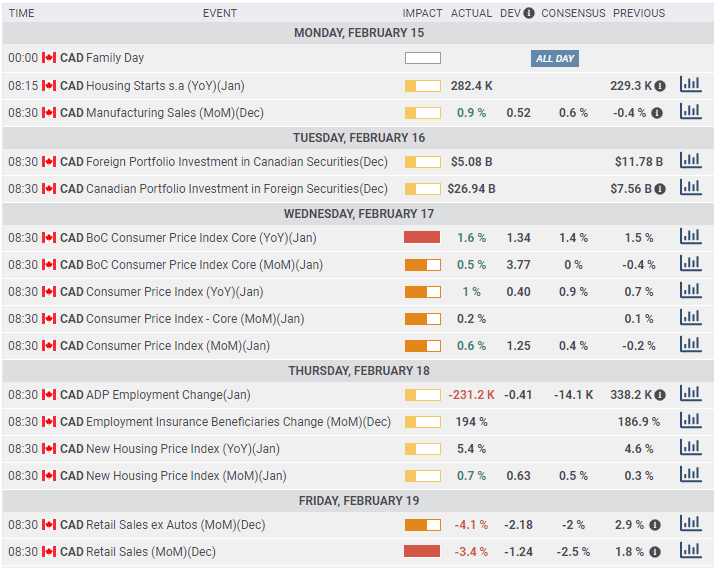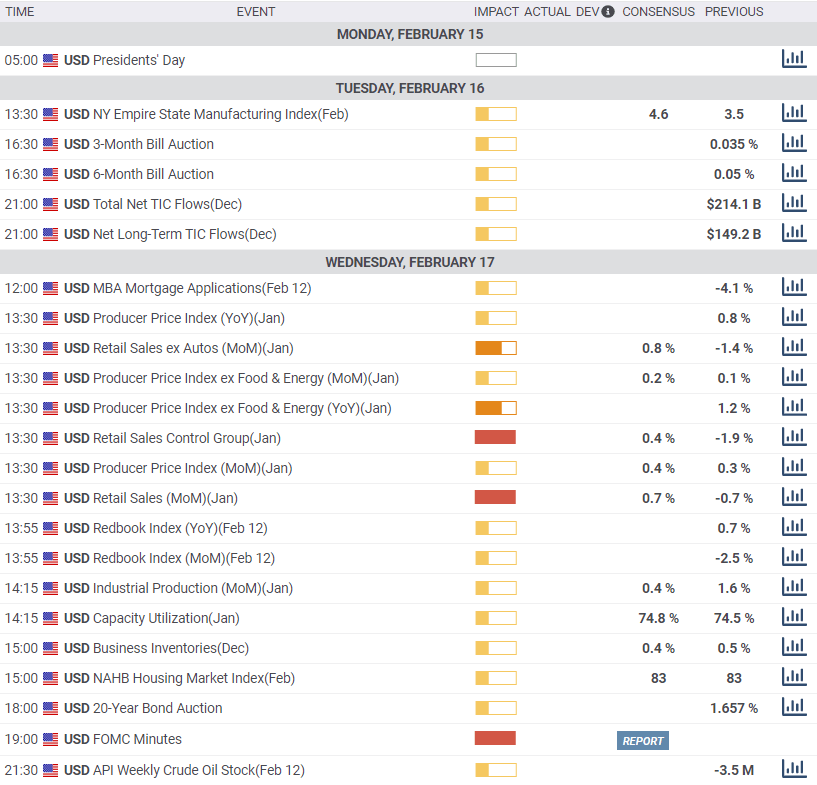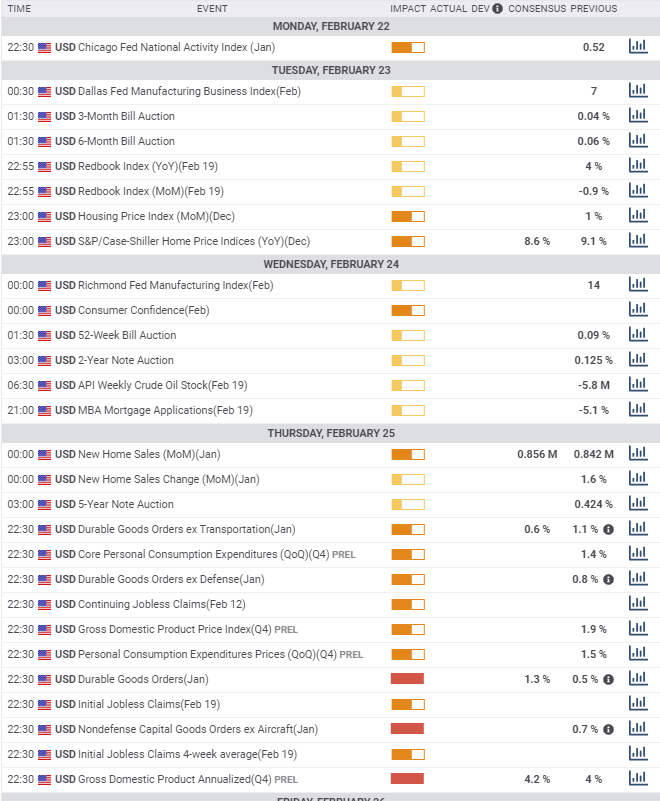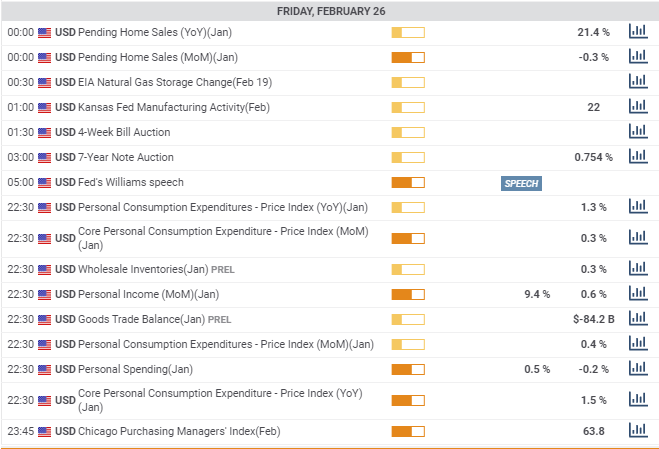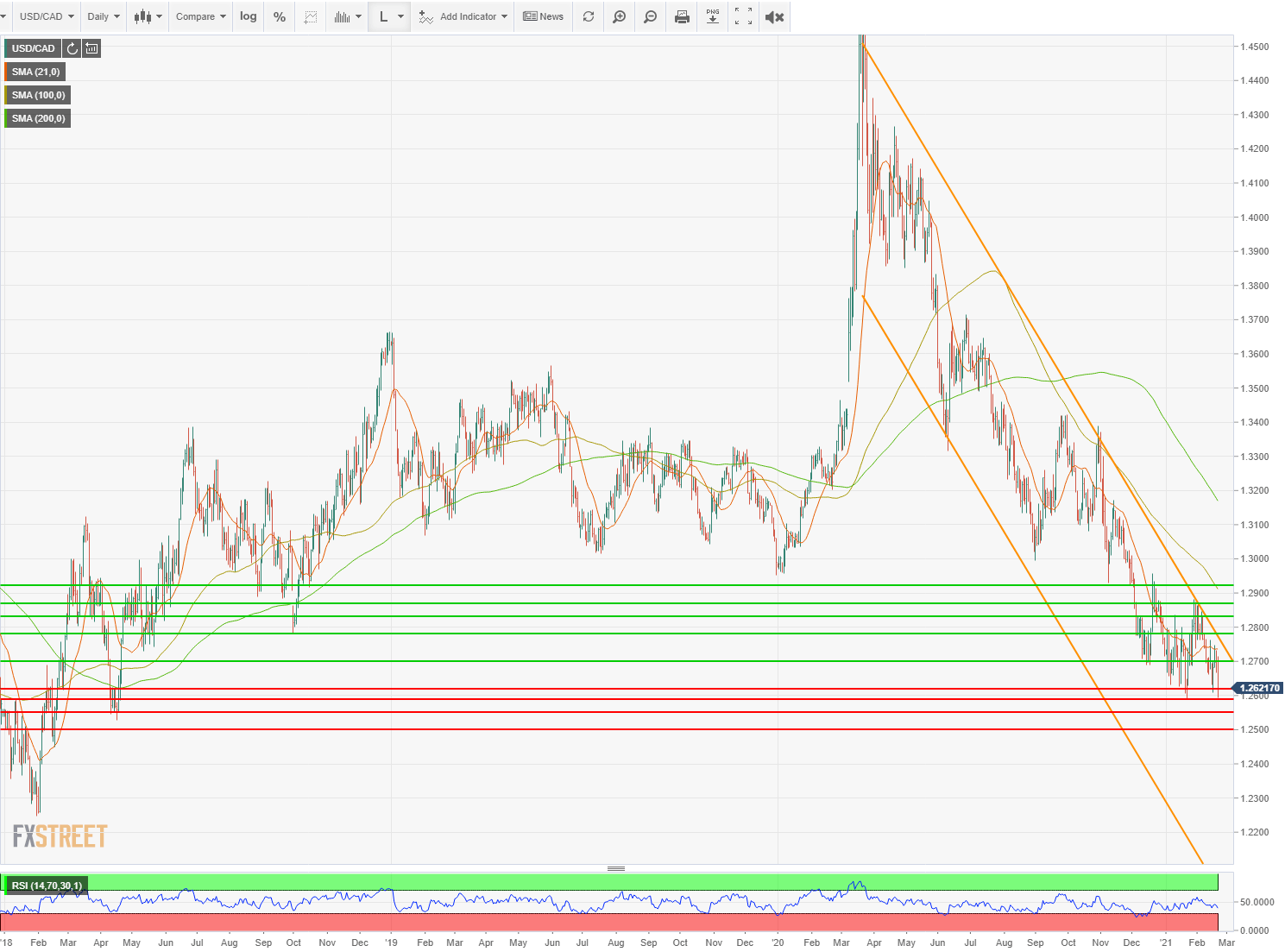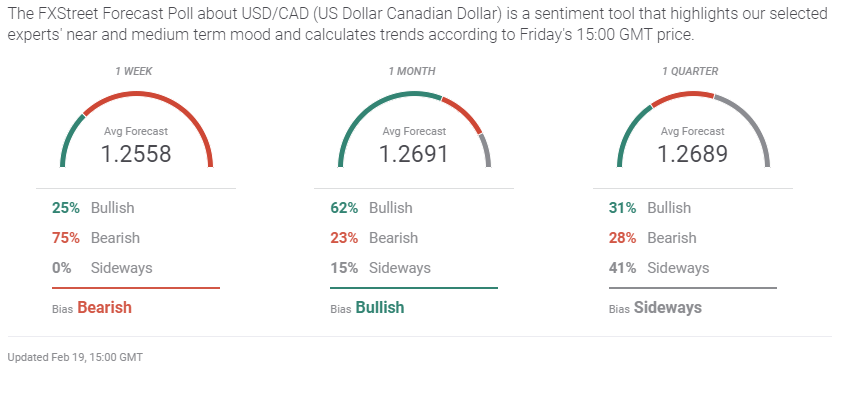- USD/CAD settles at three year low and support on Friday
- Weak Canadian Retail Sales mattered less than a 14-month high in WTI
- Commodity prices and vanishing technical support undermines USD/CAD
- FXStreet Forecast Poll expects resistance to hold at 1.2550.
Poor December Retail Sales did no harm to the Canadian dollar while the retention of West Texas Intermediate above the $58.70 support and the failure of USD/CAD to finish beyond 1.2700 resistance any day this week, pointed the pair to its lowest close in almost three years on Friday.
Except for 1.2620 where the USD/CAD finished the week, and two brief lows below 1.2600, one in January and one this month, there is no more recent support level than April 2018.
The technical pressure on the USD/CAD after the failed breakout attempt in the first week of February, the lack of support references and the continuing achievements of WTI and commodities have overwhelmed any positive impact from the rise in US Treasury rates.
Markets are also ignoring the lockdowns in Ontario and Quebec, the low vaccination numbers compared to those of the US and the UK, and the 2.8% drop in WTI from Wednesday.
The steady rise of commodity prices to levels not seen since the fall of 2018 has provided hefty support and continuing sustenance to the resource heavy Canadian GDP and the loonie. With the global economy expected to accelerate in the second and third quarters there may be more room for commodity prices to rise despite the 43% gain in the Bloomberg Commodity Index (BCOM) since the pandemic bottom in April.
Bloomberg Commodity Index (BCOM)
Canadian statistics were mixed with December Retail Sales and January ADP payrolls ignored as old information and Housing Starts and stronger inflation mooted by the already improved Canadian dollar.
American economic statistics were mostly positive, particularly January Retail Sales which suggests heavy consumer spending when the new stimulus package is finally passed. Inflation received a boost in January with the annual Producer Price Index (PPI) quadrupling to 1.3% from 0.3%, bringing it to the highest rate since August 2009. Industrial Production rose 0.9% in January and has averaged 1.05% for the last four months.
Initial Jobless Claims rose unexpectedly in the latest week, underlining the rising number of business failures after almost a year of economic and business restrictions. Strong Existing Home Sales in January and Building Permits at the highest level since the housing bubble more than a decade ago, promise construction jobs once the winter weather that covers three-quarters of the country relents.
USD/CAD outlook
The USD/CAD is primed for a move lower as the Canadian dollar anticipates the global recovery.
Even a healthy resumption of US growth, by no means assured, would have limited positive impact on the USD/CAD. As the largest trading partner of the US and a resource supplier to the world's largest economy, Canada and its currency actively participate in American success.
There is weak support at 1.2590, the January low, but nothing of consequence beneath. The combination of technical weakness for the USD/CAD and fundamental strength for the Canadian dollar likely spells further for the US dollar losses against its northern cousin.
Canada statistics February 15-February 19
The housing market retained its strong aspect in January with Starts rising 282,400 (annualized) higher even than the September 2007 bubble peak of 278,200. January core and headline inflation were stronger than projected which will provide some optimism for January Retail Sales when they are released in March. December Retail Sales fell as expected as the provincial lockdowns exacted their toll on consumption.
Monday
Manufacturing Sales rose 0.9% in December on a 0.6% forecast and November's revised 0.4% decline, initially -0.6%. Housing Starts in January were 282,400 (YoY), after December's 229,300.
Wednesday
The Consumer Price Index for January rose 0.6% (MoM) and 1% (YoY) with 0.4% and 0.9% expected and -0.2% and 0.7% in December. The Bank of Canada Core CPI was 0.5% (MoM) and 1.6% (YoY), with 0.0% and 1.4% forecast and -0.4% (MoM) and 1.5% (YoY) in December.
Thursday
ADP Employment Change dropped 231,200 positions in January on a -14,100 prediction. After the loss of 212,800 in the national rolls that was foregone.
Friday
Retail Sales in December fell 3.4% and the November result was revised to 1.8% from 1.3%; -2.5% had been forecast. Sales ex-Autos dropped 4.1%, more than double the 2% forecast, and November was revised to 2.9% from 2.1%.
US statistics February 15-February 19
Retail Sales proved US consumers can be counted on to perform their usual prodigies of spending as long as there is cash available. The rise in Initial Jobless Claims indicates that the aftermath of the lockdowns will be longer and more painful than anticipated. Producer Prices hinted that inflation might not be as quiescent as thought. The Atlanta Fed GDPNow estimate for the first quarter was unchanged at 9.5% on Thursday.
Wednesday
Retail Sales soared 5.3% in January as consumers took all of their pandemic relief payments to market, far surpassing the 1.1% forecast. The result was more than sufficient to bring the three month holiday season total into the black at a very respectable 2.9% (November -1.4%, December -1%). Sales ex-Autos soared 5.9% on a 1% estimate and the revised 1.8% loss in December. The Retail Sales Control Group led all categories at 6% in January, bringing the total for the season to 2.5% (November -1.1%, December -2.4%). Industrial Production climbed 0.9% in January, almost twice the 0.5% estimate though December was revised to 1.3% from 1.6%. Capacity Utilization rose to 75.6% in January, the best of the pandemic, from 74.9%. The Producer Price Index rose 1.3% on the month and 1.7% on the year in January far outstripping the 0.4% and 0.9% forecasts. Core PPI rose 1.2% on the month and 2% on the year, a sharp acceleration from December's 0.1% and 1.2%. The minutes of the January FOMC meeting stressed the hesitant nature of the recovery and the long-term need for economic support.
Thursday
Housing Starts slid 6% in January to 1.58 million (annualized) from 1.68 million in December as much of the country lingered under snow cover. Building Permits jumped 10.4% to 1.881 million, the highest since the housing bubble, indicating a construction boom as soon as the weather permits. The Philadelphia Fed Manufacturing Survey dropped to 23.1 in February, better than the 20 prediction but down from 26.5 in January. Initial Jobless Claims rose to 861,000 in the February 12 week from 848,000 prior, 765,000 had been forecast. Continuing Claims were 4.494 million on February 5, down from 4.558 the week before.
Friday
Markit Manufacturing PMI slipped to 58.5 in February from 59.2. Services PMI rose to 58.9 from 58.3 and the Composite PMI rose to 58.8 from 58.7. Existing Home Sales, 90% of the US market, increased 0.6% in January to 6.69 million (annualized) from 0.9% and 6.65 million in December. The forecasts had been -1.5% and 6.61 million. Except for the sales rate in October, 6.86 million, and November, 6.71 million, it was the strongest annual sales since the housing bubble of 2006-2008.
FXStreet
Canada statistics February 22-February 26
Nothing of market note this week.
Tuesday
Bank of Canada Governor Tiff Macklem's video speech to the Edmonton and Calgary Chambers of Commerce.
Friday
Raw Material Price Index for January: December 3.5%. Industrial Product Price for January (MoM): December 1.5%. Building Permits for January (MoM): December -4.1%.
FXStreet
US statistics February 22-February 26
Tuesday
Dallas Fed Manufacturing Business Index for February: January was 7. Case-Schiller Home Price Index (YoY) is forecast to gain 8.6% in December after 9.1% in November.
Wednesday
Richmond Fed Manufacturing Index for February: January 14. Conference Board Consumer Confidence for February: January 89.3
Thursday
Durable Goods Orders for January should rise 1.3% following December's revised 0.5% gain, initially 0.2%. Durable Goods Orders ex Transportation are forecast to increase 0.6% from December's adjusted 1.1% gain, originally 0.7%. Nondefense Capital Goods ex Aircraft for January: December 0.7%, revised from 0.6%. Initial Jobless Claims for February 19 week: prior 861,000. Continuing Claims for February 12 week: prior 4.494 million. Gross Domestic Product for the fourth quarter will receive its first revision, called by the Bureau of Economic Analysis 'preliminary', the first iteration is called 'advanced'. It is expected to be 4.2% after the initial 4%. New Home Sales in January are expected to rise 1.5% to 856,000 annualized from 1.6% and 842,000 in December.
Friday
Kansas Fed Manufacturing Activity Index for February: January 22. The Personal Consumption Expenditure Price Index for January: December 0.4% (MoM), 1.3% (YoY); core 0.3% (MoM), 1.5% (YoY). Personal Income in January is forecast to rise 9.4% after December's 0.6% increase. Personal Spending is expected to increase 0.5% in January after falling 0.2% prior. Wholesale Inventories for January: December 0.3%.
USD/CAD technical outlook
The technical position of the USD/CAD is weak. Resistance levels are more numerous and recent, the eleven-month descending channel is intact and formidable and support depends on ranges traded more than three years ago. All three moving averages are resistance points above with the 21-day at 1.2736 in current play and the 100-day at 1.2912 and the 200-day at 1.3170 indicative of the long-runnning negative trend. The Relative Strength Index at 39.10 is not close to being oversold despite the decline of the past three weeks. The Friday USD/CAD finish at the last major support of 1.2620 invites a test lower in Monday's Asian markets.
Resistance: 1.2700; 1.2780; 1.2830; 1.2865; 1.2920
Support: 1.2620; 1.2590; 1.2550; 1.2500
USD/CAD Forecast Poll
The FXStreet Forecast Poll predicts a technical bounce from the 1.2550 support level followed by consolidation beneath 1.2700 resistance.
Information on these pages contains forward-looking statements that involve risks and uncertainties. Markets and instruments profiled on this page are for informational purposes only and should not in any way come across as a recommendation to buy or sell in these assets. You should do your own thorough research before making any investment decisions. FXStreet does not in any way guarantee that this information is free from mistakes, errors, or material misstatements. It also does not guarantee that this information is of a timely nature. Investing in Open Markets involves a great deal of risk, including the loss of all or a portion of your investment, as well as emotional distress. All risks, losses and costs associated with investing, including total loss of principal, are your responsibility. The views and opinions expressed in this article are those of the authors and do not necessarily reflect the official policy or position of FXStreet nor its advertisers. The author will not be held responsible for information that is found at the end of links posted on this page.
If not otherwise explicitly mentioned in the body of the article, at the time of writing, the author has no position in any stock mentioned in this article and no business relationship with any company mentioned. The author has not received compensation for writing this article, other than from FXStreet.
FXStreet and the author do not provide personalized recommendations. The author makes no representations as to the accuracy, completeness, or suitability of this information. FXStreet and the author will not be liable for any errors, omissions or any losses, injuries or damages arising from this information and its display or use. Errors and omissions excepted.
The author and FXStreet are not registered investment advisors and nothing in this article is intended to be investment advice.
Recommended Content
Editors’ Picks
EUR/USD edges lower toward 1.0700 post-US PCE

EUR/USD stays under modest bearish pressure but manages to hold above 1.0700 in the American session on Friday. The US Dollar (USD) gathers strength against its rivals after the stronger-than-forecast PCE inflation data, not allowing the pair to gain traction.
GBP/USD retreats to 1.2500 on renewed USD strength

GBP/USD lost its traction and turned negative on the day near 1.2500. Following the stronger-than-expected PCE inflation readings from the US, the USD stays resilient and makes it difficult for the pair to gather recovery momentum.
Gold struggles to hold above $2,350 following US inflation

Gold turned south and declined toward $2,340, erasing a large portion of its daily gains, as the USD benefited from PCE inflation data. The benchmark 10-year US yield, however, stays in negative territory and helps XAU/USD limit its losses.
Bitcoin Weekly Forecast: BTC’s next breakout could propel it to $80,000 Premium

Bitcoin’s recent price consolidation could be nearing its end as technical indicators and on-chain metrics suggest a potential upward breakout. However, this move would not be straightforward and could punish impatient investors.
Week ahead – Hawkish risk as Fed and NFP on tap, Eurozone data eyed too

Fed meets on Wednesday as US inflation stays elevated. Will Friday’s jobs report bring relief or more angst for the markets? Eurozone flash GDP and CPI numbers in focus for the Euro.




